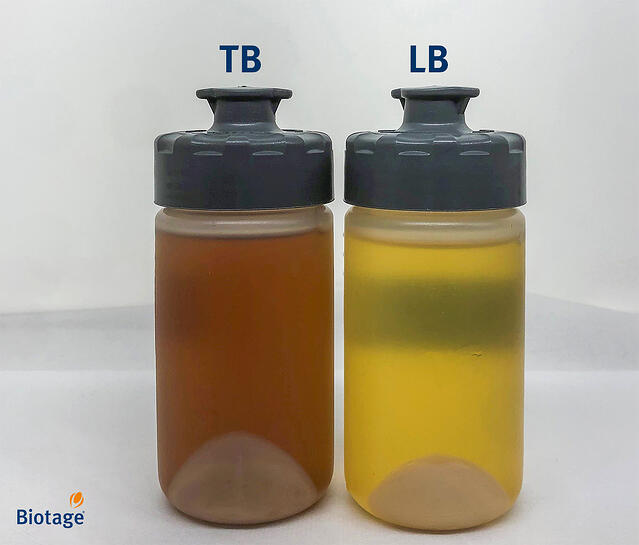One of the biggest challenges with automated plasmid purification is with culture growth conditions, leading to low yielding cultures. Many times, culture growth is unpredictable and hard to perfect. Large volume culture growth is an additional struggle. But it’s important to optimize your culture growth, because when your culture growth conditions are reliable, your downstream processing will be more successful and higher yielding. Here are a couple of recommendations for successful large scale culture growth.
For large scale culture growth, using rich medias, such as Terrific Broth (TB), Thomson Plasmid+, or Agencourt Ale, will offer the best growth and higher plasmid yields. Rich medias have the highest impact on cell growth density, resulting in denser cultures and cultures with more plasmid per cell than cultures grown in LB, or similarly non-rich media.
Another great accelerator for denser, more consistent culture growth is to use a starter culture. In traditional culture growth, most scientists start by picking a single colony from a plate, but these cells are not actively producing plasmids, and it will take at least a few hours for them to reach the log phase of exponential growth. When using a starter culture, the cells are already growing happily and are well into the log phase when an aliquot is taken for overnight growth. This will give the culture more time in log phase, and the result will be a higher cell density and happier cells. Also, when inoculating multiple flasks, a starter culture ensures the same amount of cells is transferred to the overnight culture, as opposed to multiple colony picks which will contain a varying number of cells per pick. This guarantees flask to flask consistency, and more predictable plasmid yields between preps. It is also possible to begin a starter culture in LB and then transfer the dilution into TB to reach that higher cell density.
For best success, grow the starter culture for 6-8 hours (easily done during the work day), then use a 1:1000 dilution of the starter culture for overnight growth, which should be incubated at 37ﹾC and 350 RPM. Certain plasmid vectors such as pUC19 will increase in copy number when grown at slightly higher temperatures. Using a richer media also allows for cells to be grown longer, up to 16 hours overnight, making preparing cell culture in advance a bit easier.

Figure 1: Spun down cell pellets of cultures grown in TB (left) and LB (right). The cell pellet in the TB sample is significantly larger than the cell pellet in the LB sample.
Rich medias can also help increase growth in small cultures for MiniPrep. For small cultures, it is also important to use fresh colonies, preferably no longer than a week old. For both small and large culture growth, an extremely important factor for getting high density cultures is to use high or very high copy plasmids.
| Sample | Nucleic Acid (ng/uL) |
Volume (mL) |
Yield (mg) |
A260/A280 | A260/A230 |
| TB 1 | 355.356 | 4.63 | 1.64 | 1.871 | 2.335 |
| TB 2 | 366.448 | 4.63 | 1.70 | 1.872 | 2.335 |
| LB 1 | 231.656 | 4.63 | 1.07 | 1.863 | 2.397 |
| LB 2 | 228.087 | 4.63 | 1.06 | 1.864 | 2.4 |
Figure 2: Yield data from the cell pellets pictured above (Figure 1). Four pellets were grown from the same starter culture, 2 grown in TB and 2 grown in LB. The data shows that cultures grown in TB result in a significantly higher plasmid yield than those grown in LB. The yields between each media type are also consistent in yield and purity.
For more information on our automated MiniPrep and Maxi, Mega, Giga plasmid purification solutions, read more.

